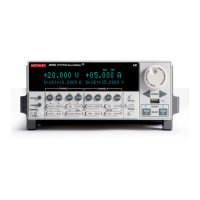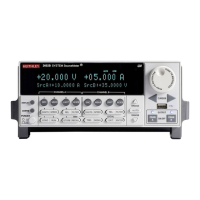Model 2657A High Power System SourceMeter® Instrument Reference Manual Section 4: Theory of operation
2657A-901-01 Rev. B/December 2012 4-5
Operation as a sink
When operating the Model 2657A in the second or fourth quadrant, the SMU operates as a load that
sinks and dissipates the power internally. The SMU’s ability to dissipate power is defined by the
boundaries shown in the previous figure. When operating the Model 2657A in the second or fourth
quadrant, the DUT would be a power source (such as a battery, solar cell, or a power supply).
Use care when connecting a source to the Model 2657A that is capable of exceeding 120 mA. Using
the Model 2657A to sink more than 120 mA can damage the instrument and invalidate your warranty.
When operating as a sink within the continuous operating boundaries, the SMU operates as
programmed. Programming source or compliance values will not cause the SMU to operate outside
of these boundaries. The SMU treats these boundaries as a compliance limit known as the sink limit;
the sink limit cannot be programmed by the user. The SMU deters operation outside of its sink limit by
reducing its voltage. If the sink limit is reached, the source field on the display flashes and the sink
limit bit is set in measurement event register of the status model (see Measurement event registers
(on page E-8)). For examples of instrument configuration in sink mode, see I-source sink operating
boundaries (on page 4-16) and V-source sink operating boundaries (on page 4-10).
V-source operating boundaries
Model 2657A V-source operating boundaries
The following figure shows the operating boundaries for the V-source. Only the first quadrant of
operation is shown; operation in the other three quadrants is similar with respect to the Continuous
power operating boundaries (on page 4-4).
CAUTION
